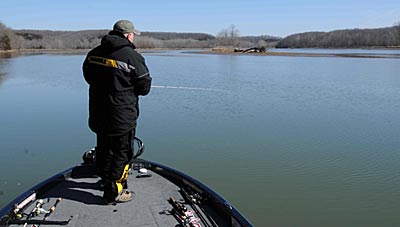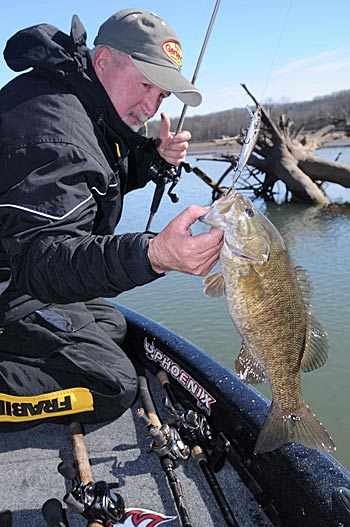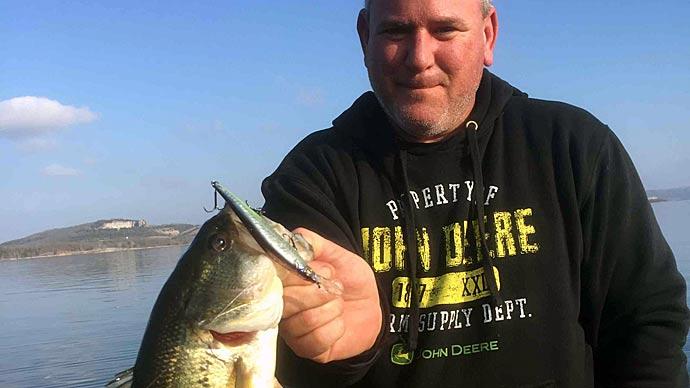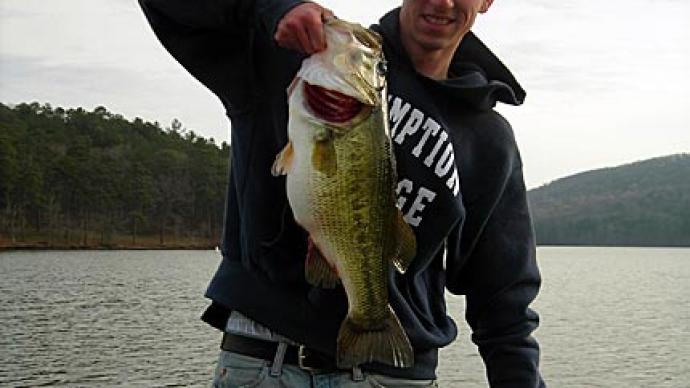
Terry Blankenship likes to run up a creek without a paddle to catch early spring bass.
The Missouri angler runs up the tributaries of Ozark highland reservoirs with his outboard engine until the water gets too skinny. Then he moves farther up the creek or river with his trolling motor to reach early spring bass.
“In early spring, there is always a migration of fish that go up the rivers,” Blankenship says. He believes bass in the tributaries migrate down into the lake in late fall and early winter to find warmer and more stable conditions in deeper water. Then when warm spells and longer daylight hours occur in early spring, bass leave the deeper water and migrate to the riverine sections of the upper lake.
Rain runoff will also cause bass to move into the rivers, but Blankenship avoids targeting tributary bass then because the fish are on the move, which makes them harder to pinpoint. The river could also be high and muddy, especially after heavy rains. “If it is a big rain, it gets the creeks running big,” Blankenship says. “Then your odds have gone down a lot because that limits you to only a few spots to fish.”
Warmer water flowing into the lake from the tributaries also triggers bass to migrate up the rivers and creeks. “Once the river water gets warmer than the lake water, that is just a trigger,” Blankenship says.

That’s the time to follow the bass up the creek or river “as far as your boat will let you,” according to Blankenship. The depth of bass in the tributaries varies. “Some rivers just don’t have a lot of depth,” Blankenship says. “Many rivers have filled in with gravel and have lost some of the main holes. But there is always current that causes some area to get dug out. Any time you can find a place with a little sheltered area where there is a turn in the river or a log, it gives those fish a chance to ambush whatever bait comes through there or just rest up there.
“Any time you find some type of small eddy that has some kind of current break in it, the fish will pile up in those places,” Blankenship says. “You can then catch a lot of fish in one spot, which makes the river fishing fun early in the year.”
The regional tournament angler first begins searching for tributary bass in the deeper holes. The tributaries also feature vast mud flats strewn with partially or wholly submerged logs and steep rock banks, both of which hold bass.
Sunshine determines if bass are more active on the flats or the steeper rock banks. “There will be days whenever the sun has been beating on the rocks, and the fish will be right up on the shoreline where as soon as your bait hits the water, you will catch them right tight to the bank,” Blankenship says.
“It is always nice to have a good sunny day,” Blankenship says. The water in the tributaries usually has some stain to it, so the dirtier water absorbs the warmth of the sunshine, and the warmer water then activates the bass.
The water temperature in the tributaries usually dictates which lures Blankenship prefers throwing for early spring bass. During the earliest stages of the bass migration into the tributaries, Blankenship tries slow-moving lures such as suspending jerkbaits, jigs, or a Texas-rigged Gene Larew Lures Hoo Daddy creature bait. If the weather has been sunny and warm for a few days, he suggests trying faster moving lures such as Storm Lures Wiggle Wart crankbaits or spinnerbaits.
Fishing the tributaries in the early spring can produce a mixed bag of smallmouth, largemouth, and spotted bass. Blankenship frequently catches numbers of bass in the tributaries and some quality fish in the 4- to 5-pound range.
The tournament competitor notes the tributary pattern can last for two to three weeks until the fishing pressure starts slowing down the bite or the bass migrate farther upriver than his bass boat can travel. He suggests anglers with jet-driven boats can run farther up the river to continue catching those fish throughout the spring and summer.
The tributaries contain plenty of navigation hazards, such as logs wedged in the mud bottom of the channel and the shallow mud flats, so Blankenship advises using extreme caution when running up the creeks and rivers. “I recommend you take your time any time you are in unfamiliar water that you think has a lot of shallow logs and debris and rocks that can tear up your boat or even harm yourself,” he says.
Navigating at idle speed is a reasonable safety precaution whenever you see logs sticking up in the middle of the tributary.




